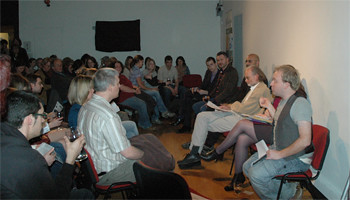The following is an essay by Dr. Chris Groves and relates to the Robot and Frank sciSCREEN last night.
Why does Frank wipe Robot’s memory? This is a central
question in a film which, in many ways, is about a man’s relationship with an
ambiguous, even uncanny object – and therefore is a film that invites us to
think about what philosophers might call the phenomenology of objects, that is,
how objects of certain help to structure our conscious experience of the world,
and their meaning within it.
Not long after meeting Robot for the first time, Frank says
‘I can’t believe I’m talking to an appliance’. It’s true we often talk to
appliances, usually angrily. To some extent we tend to be a little animistic in
our relationships with technological gadgets in particular, to the point where
we may treat them as possessing a kind of autonomy. But Frank’s relationship with Robot develops far beyond this. By
the midway point of the film, Frank has regaled Robot with tales of his past,
tried to excuse his former life of crime to him (it’s the insurers who pay, he
only took high value items from rich people), and has gone as far as exploiting
his programming to use him as an accomplice. But he also comes to refer to
Robot, while speaking to others, as ‘my friend’. After his daughter Madison has
temporarily switched Robot off, Frank addresses him as ‘buddy’ while trying to
wake him up.
After this, Robot makes the entirely rational (from a
certain perspective) point that Frank should just wipe Robot’s memory, so they
can go on committing crimes without the risk of incriminating evidence. If Robot were merely an appliance, would
Frank hesitate? He refuses, however, as if there is something distasteful or
repugnant about this idea. Is this because Robot is his friend? In what sense
could Robot be a friend? In his Nicomachean
Ethics, Aristotle described friendship as a kind of human relationship in which one has a desire to
benefit the other person for his/her own sake. But what makes someone a friend
in the first place is their character: we see something admirable in what they
do, in the choices they make. They create projects that we see as worthwhile
and wish to see flourish. This capacity to be source of novelty, to provide a
unique ‘take’ on the world in which we see value and significance, was
identified by the German philosopher Hannah Arendt as the source of human
beings’ unique value. With human action ‘something new is started which cannot
be expected from whatever may have happened before’ (Arendt, The Human Condition, 1953[1998], pp.
177-178).
For a while, Robot is undoubtedly something like a friend.
Frank’s son Hunter buys Robot to take care of Frank’s material needs: check
blood pressure, check nutrient intake, and to perform a variety of other
utilitarian tasks. Yet Robot’s carrying out of these caring tasks also provides
Frank with something else: Robot becomes for Frank another subject who can
reflect back to him his life but also help him to see himself differently. Then
he becomes an accomplice – a partner in a common enterprise, someone who shares
with Frank a common fate. He helps Frank to go beyond the pointless repetition
that populates his days at the beginning (stealing random objects from the
candle shop), and to regain a sense of having a future that matters and that
changes the meaning of the present. And this future also appears to matter to
Robot: he is concerned with risks, with how things will turn out in the end,
the kind of forward-looking concern that we would expect a friend to show.
Yet Frank still wipes his memory. Why? In his last
conversation with Frank before his memory is wiped. Robot convinces Frank he
should flick the switch. While Frank is wondering what to do, Robot relays back
to him verbatim what Frank told Robot earlier about his criminal career – how
only the insurers lose out, how only the big value items are worth taking, and
so on. He simply mechanically repeats the words, making Frank realise that
Robot is not an agent in his own right, capable of his own take on the world
and capable of acting in ways which, as per Arendt, cannot be expected. This
insight was prefigured in the earlier encounter between the two robots at the
party: neither was able to start a conversation with the other. And so Frank
realises that Robot cannot, ultimately, be his friend – that he can sacrifice
him in order to escape the Sheriff and Jake. And yet... the gesture of flicking
the switch is filmed to look like an embrace. Does Robot really revert, at this
point, to being just an appliance for Frank?
Our relationships with objects, especially technological ones, are often far more ambiguous than we sometimes allow. Robot is somewhat like a friend, with evident limitations. Yet he is far more than an appliance. For Aristotle, friendship had a specific value: not instrumental, means-end value, but constitutive value. The friend is valued because she, by being an end in herself with her own ‘take’ or perspective on things, adds meaning to the world. The kind of value she has is constitutive value: her wellbeing is an ingredient in our wellbeing. Now, some things also have value in this sense. We often forget that the things around us are generally, ambiguous objects – not just utilitarian, purely instrumental things. Anthropologists and sociologists describe how, from indigenous cultures to post-industrial societies, objects always have symbolic functions as well as just use-value: exchanging and acquiring them is part of social processes that mark status distinctions, create fashions and so on. But the objects we live with are also participants within emotional, affective relationships as well as symbolic ones. The anthropologist Daniel Miller has described in his book The Comfort of Things (2009), how relationships with certain objects – as diverse as record collections, bicycles, and Christmas decorations – shape the meaningfulness of lives. Objects in this sense are not just objects, they are attachment objects. The throwaway statement that something has ‘only sentimental value’ hides a vital and sustaining connection between things and people.
Attachment in developmental psychology describes the
emotional relationship between infants and their caregivers. Caregivers feed,
change and settle babies for sleep. But this is more than just attending to
their bodily needs. The emotional connection between them constructs, as the
child develops and its needs grow and change, a ‘safe space’ from within which
he or she can explore the world. The psychoanalyst D.W. Winnicott noted that significant objects in our lives act as 'transitional objects' – all the way from cuddly toys to religious artefacts and
artworks. They extend the safe space from within which we can experience the
world around us as trustworthy and reliable, and as a place we can meaningfully
influence through our actions. Objects of attachment thus play a role that
substitutes for caregivers. We can turn to them for reassurance about who we
are and about how our actions have significance within the world. Like
caregivers, we need them to fulfil various specific needs – a bike gets us to
work, a record collection provides us with entertainment. But our need for them
goes beyond our utilitarian needs. Objects of attachment have importance
because they are a source of meaning, they are in a sense inexhaustible – we
can keep coming back to them and each time they reassure us, confirm our
perspective on the world, or enable us to make new sense of the world. We find
in them a kind of constitutive value like that Aristotle finds in friendship.
They sustain our sense of who we are and what we can do; as with friends,
things can go worse or better for them; what happens to them has an effect on
us. A trusted bike has to be cleaned, kept roadworthy, polished; the Xmas
decorations we had when children and have inherited from our parents have to be
kept safe in the attic. Damage to such constitutively valuable objects is felt
as a blow against our self: as with friendship, what injures the attachment
object injures the person who cares about and for it.
Frank’s conspiracy with Robot builds an attachment
relationship with these kinds of features. Robot reawakens Frank’s former
world, vivifying bodily memory and his use of old skills, like lock-picking.
His relationships with his children change, he becomes more autonomous. In this
way, Frank’s memories are seen to be embodied, not simply impressions which can
be retrieved through mental acts. Doing things with Robot as part of their
‘conspiracy’ gives Frank back his sense of himself. And what happens to Robot
therefore matters to Frank: what happens to him – and what he does – affects
the meaning of Frank’s own life. Frank’s act of reformatting Robot’s memory
(which, as I noted above, is filmed as a kind of embrace) is a breaking of
attachment, done with regret and consciousness of loss, the end of a meaningful
episode in his life.
Yet there is another twist in Frank’s relationship with
Robot. Suppose that Robot were, indeed, a friend who loved Frank for his own
sake and wanted him to remain free – a friend for whom an injury to Frank would
be an injury to Robot. Wouldn’t Robot attempt to convince Frank that he is only
an appliance, only capable of mindlessly reflecting Frank’s words back to him?
Wouldn’t this be exactly what a true
friend would do – an act of self-sacrifice?
Perhaps this is what Frank is wondering when at the end of
the film, as he returns to his room in the memory centre, another resident’s
Robot glances at him, with what we could almost imagine is a look of
recognition. The object of attachment is of value to us because it remains
mysterious, somehow more than what it appears to be. It doesn’t simply fit into
our plans as an instrument of our purposes, like objects which just have
utilitarian value: it sticks out into the world. There is always something more
to be said about it, it insists
itself within our perspective on the world, makes demands on us. Although it is
familiar, welcoming and comforting, there is something about it that reminds us
of Freud’s concept of the Uncanny
(Unheimlich) [PDF]. The German
psychologist Ernst Jentsch, who influenced Freud’s thinking, wrote in 1906 that ‘one of the most reliable artistic devices for producing uncanny
effects easily is to leave the reader in uncertainty as to whether he has a
human person or rather an automaton before him in the case of a particular
character’ (Jentsch, 1997, ‘On the psychology of
the uncanny’ (1906) Angelaki, 2(1), pp.
7-16: p. 13). This feeling is what the end of Robot and Frank gently insinuates. Yet it is, I’d suggest, a
special case of the ambiguity with which material objects of attachment in
general surround us.








No comments:
Post a Comment